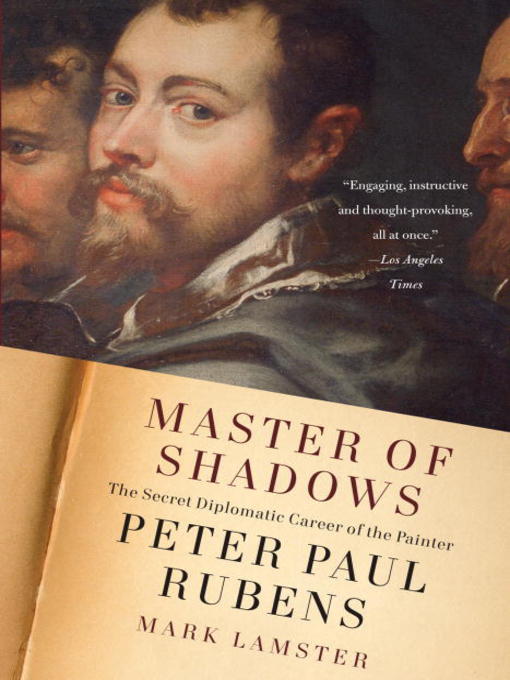Although his popularity is eclipsed by Rembrandt today, Peter Paul Rubens was revered by his contemporaries as the greatest painter of his era, if not of all history. His undeniable artistic genius, bolstered by a modest disposition and a reputation as a man of tact and discretion, made him a favorite among monarchs and political leaders across Europe—and gave him the perfect cover for the clandestine activities that shaped the landscape of seventeenth-century politics.
In Master of Shadows, Mark Lamster brilliantly recreates the culture, religious conflicts, and political intrigues of Rubens’s time, following the painter from Antwerp to London, Madrid, Paris, and Rome and providing an insightful exploration of Rubens’s art as well as the private passions that influenced it.
Master of Shadows
The Secret Diplomatic Career of the Painter Peter Paul Rubens
-
Creators
-
Publisher
-
Release date
October 20, 2009 -
Formats
-
Kindle Book
-
OverDrive Read
- ISBN: 9780385532235
-
EPUB ebook
- ISBN: 9780385532235
- File size: 2341 KB
-
-
Languages
- English
-
Reviews
-
Kirkus
August 1, 2009
Biography of Peter Paul Rubens (1577–1640), influential painter, diplomat and sometime spy whose foremost goals were to avert war and return his beloved Antwerp to glory.
With a map, chronology, list of principal players and a mostly lucid prose style, freelance journalist Lamster (Spalding's World Tour: The Epic Adventure that Took Baseball Around the Globe—and Made it America's Game, 2006) does much to simplify a tangled story of monarchs, aristocrats, diplomats, international alliances, poets, painters, wives and colleagues. The author charts Rubens's quick rise to artistic prominence, pausing only occasionally to discuss a particular work. Lamster notes that it was not just Rubens's artistic gifts that suited him for diplomatic service. He was polyglot (fluent in a half-dozen languages), tall and handsome, charismatic, highly organized, moderate and circumspect. He was also a loyal husband and devoted father. As a popular painter traveling to foreign courts, he was uniquely positioned to eavesdrop and, eventually, carry dispatches and proposals and advocate official policy. The politics of the day involved—no surprise—the quest for global power, and the great seafaring states of Western Europe (France, England and Spain, with occasional forays by the Italians and Danes) were maneuvering constantly to improve their relative positions. The rising Lowlands were divided into two large entities, which, for convenience's sake, the author calls Holland (in the north) and Flanders (in the south, under the control of Spain). Antwerp lay south, so Rubens represented the Spanish in a number of diplomatic missions—some successful, some not; some covert, some not—to England, France and elsewhere.
Though sometimes eye-glazingly complex, Rubens's story surprises and dazzles.(COPYRIGHT (2009) KIRKUS REVIEWS/NIELSEN BUSINESS MEDIA, INC. ALL RIGHTS RESERVED.)
-
Library Journal
Starred review from November 15, 2009
This book relates the exceptionally active diplomatic career of acclaimed painter Peter Paul Rubens (15771640). It's a story unknown to most readers, even admirers of Rubens's work. Serving the kings of Spain but also the archduke and archduchess who governed the Spanish Netherlands, Rubens crisscrossed Europe for over 25 years, negotiating treaties and seeking accommodations among Europe's sovereigns. Though in the top ranks of the Flemish bourgeoisie, Rubens was still only a commoner. That he was tapped to lead these diplomatic efforts testifies to his standing as both an artist and a man of personal qualities. His network of friends and correspondents put him in a unique position, but in the end, his efforts failed, swallowed up in the deluge of destruction of the Thirty Years' War. Lamster explains all this without simplifying the labyrinthine politics of this tumultuous age. An added benefit is his appreciation of, and ease in explaining, the complex iconography and artistic values exposed to view in Rubens's great artworks. VERDICT An exceptional book that should appeal to history lovers and art lovers alike.David Keymer, Modesto, CACopyright 2009 Library Journal, LLC Used with permission.
-
Formats
- Kindle Book
- OverDrive Read
- EPUB ebook
subjects
Languages
- English
Loading
Why is availability limited?
×Availability can change throughout the month based on the library's budget. You can still place a hold on the title, and your hold will be automatically filled as soon as the title is available again.
The Kindle Book format for this title is not supported on:
×Read-along ebook
×The OverDrive Read format of this ebook has professional narration that plays while you read in your browser. Learn more here.


